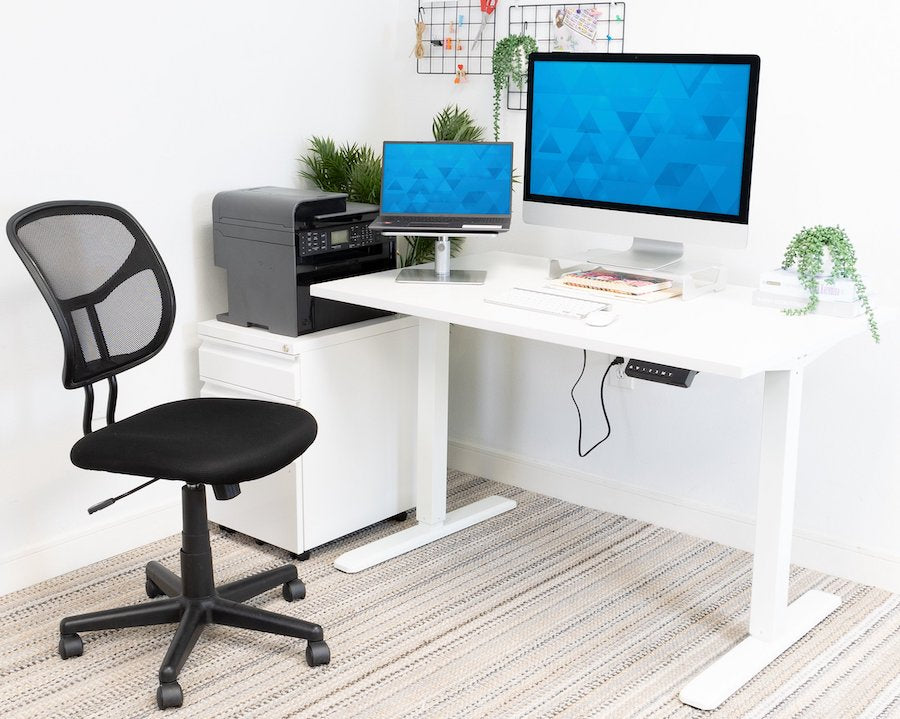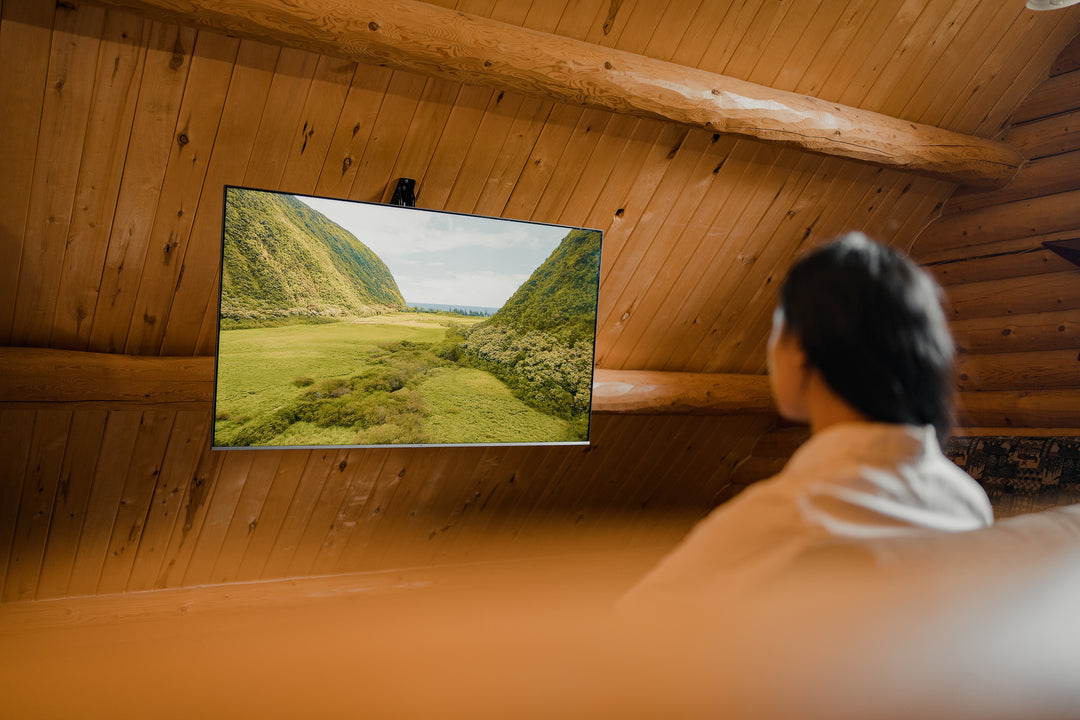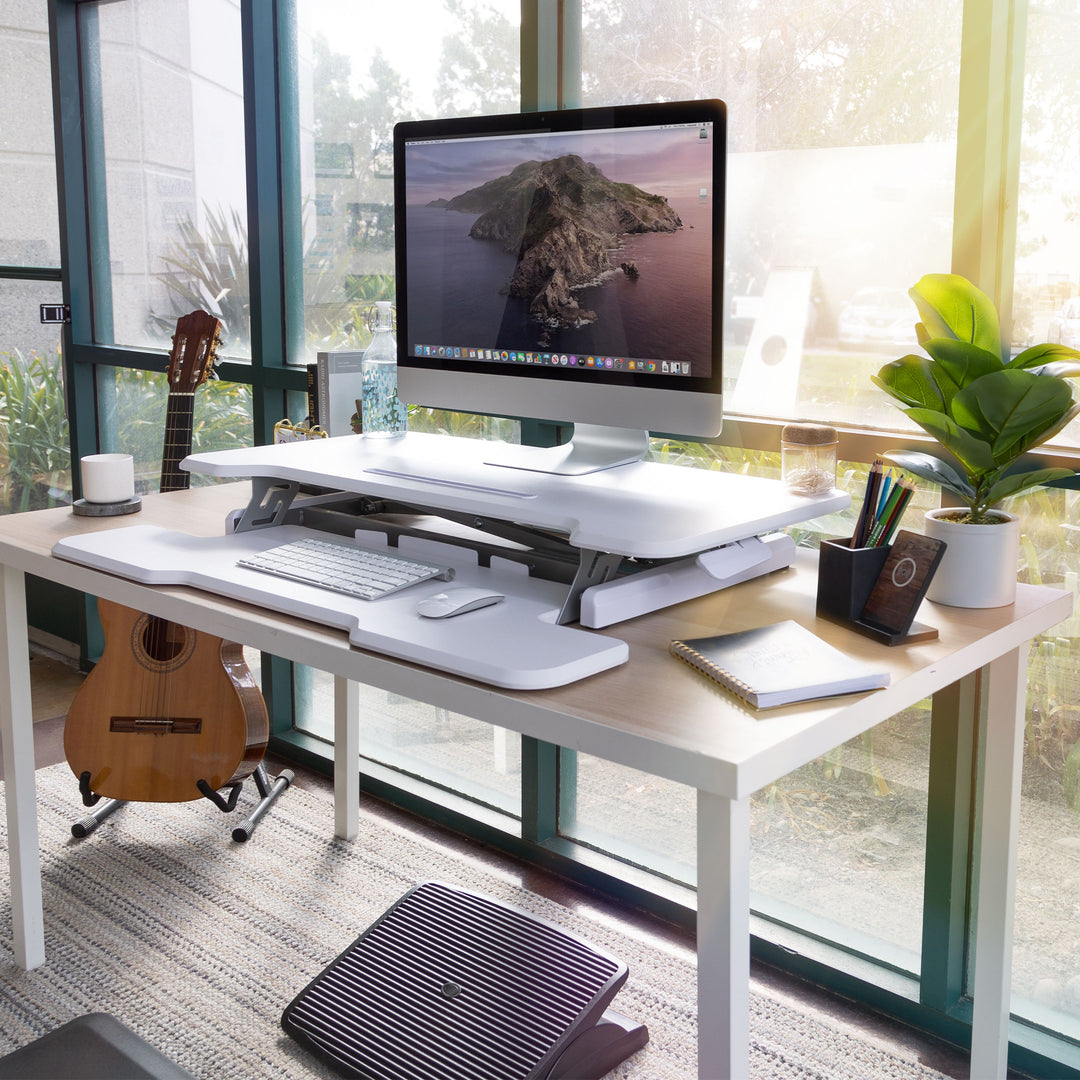Optimal Desk Ergonomics For Comfort

An ergonomic desk set-up is essential for maintaining a comfortable and healthy work environment. Poor desk ergonomics can lead to a variety of issues, such as neck pain, back pain, and eye strain. By adjusting your chair and desk to match your individual body height, you can optimize your desk ergonomics for comfort and reduce the risk of developing discomfort or pain associated with poor posture. A monitor arm or a laptop stand combined with a comfortable keyboard and mouse can complete your set-up. Remember to take breaks throughout the day and move your body regularly to avoid prolonged periods of sitting.
Desk Ergonomics Enhance Productivity
Proper desk ergonomics can enhance productivity by reducing physical discomfort and fatigue, which can lead to distractions and decreased focus. When you are in a comfortable and ergonomic position, your body is less likely to experience strain, pain, and fatigue, allowing you to focus more effectively on your work. For example, if you are experiencing neck or back pain due to poor posture, you may find it difficult to concentrate on your work. Similarly, if you are using a keyboard or mouse that causes discomfort or strain in your wrists, you may find it hard to type or use your computer mouse effectively. By optimizing your desk ergonomics and reducing physical discomfort, you can improve your overall well-being and increase your productivity. When your body is in a comfortable and healthy position, you can work more efficiently and with less distraction, allowing you to achieve your goals more quickly and effectively.
What Is the Correct Ergonomic Desk Setup?
The correct ergonomic desk setup may vary depending on your specific needs and preferences, but here are some general guidelines to follow:
- Chair: Choose a chair that is adjustable in height, has good lumbar support, and allows your feet to rest comfortably on the ground. Adjust the height of the chair so that your thighs are parallel to the ground and your feet are flat on the floor.
- Desk: Position the desk at a height where your elbows are bent at a 90-degree angle when typing. Your keyboard and mouse should be at the same level, and you should be able to use them without reaching or straining your arms. Ideally, use a sit-stand desk that allows you to switch between sitting and standing frequently throughout the day.
- Monitor: Position the monitor at arm's length and at a height where the top of the screen is at or slightly below eye level. You should not have to tilt your head up or down to view the screen.
- Keyboard and Mouse: Place your keyboard and mouse close to the edge of the desk so that you can keep your wrists straight when typing. Use a wrist rest if necessary.
- Lighting: Ensure that your workspace is well-lit to reduce eye strain. Use a desk lamp to supplement overhead lighting.
- Posture: Sit up straight and keep your shoulders relaxed. Avoid slouching or hunching over the desk.
- Take breaks: Take regular breaks to stretch and move around. Stand up and walk around for a few minutes every hour to reduce the risk of discomfort or strain.
Everything You Need For An Ergonomic Workstation
Creating an ergonomic workstation is essential for maintaining good posture and reducing physical strain while working. Here are some items that might help you work healthy and comfortably:
- Adjustable chair: An adjustable chair that provides lumbar support and allows you to adjust the height, backrest, and armrests can help you maintain good posture and reduce physical strain.
- Footrest: If your feet don't touch the ground when sitting in your chair, a footrest can help you maintain proper posture and reduce pressure on your legs.
- Height adjustable desk: Ensure your desk is height adjustable so that you can adjust it to your ideal sitting position. Even better is a sit-stand desk (electric or manual) that allows you to change between sitting and standing throughout the day.
- Ergonomic keyboard and mouse: An ergonomic keyboard and mouse can help reduce the risk of wrist and hand strain. Look for products that are designed to keep your wrists and hands in a neutral position.
- Adjustable monitor arm: An adjustable monitor arm allows you to easily adjust the height and angle of your monitor to reduce eye strain and neck pain.
- Desk lamp: Good lighting is essential for reducing eye strain. A desk lamp can supplement overhead lighting and help you avoid glare and shadows.
- Anti-fatigue mat: If you stand at your desk for longer periods, an anti-fatigue mat can help reduce foot and leg fatigue.
- Document holder: A document holder can help you avoid straining your neck and shoulders when reading or typing from a document.
- Wireless headset: If you spend a lot of time on the phone, a wireless headset can help you avoid neck and shoulder strain from holding a phone.
By incorporating these items into your workstation, you can create a comfortable and healthy environment that supports good posture and reduces physical strain. Remember, the key to a good ergonomic workstation is finding the right combination of items that works for your individual needs and preferences.
The Best Ergonomic Office Chair
There are many great ergonomic office chairs on the market, but the best chair for you will depend on your individual needs and preferences. Here are some popular ergonomic office chairs that are highly recommended by experts and users:
- Herman Miller Aeron: The Herman Miller Aeron is a top-of-the-line ergonomic chair that features adjustable lumbar support, seat height, armrests, and tilt. It's made with high-quality materials and is designed to support a wide range of body types and sizes.
- Steelcase Gesture: The Steelcase Gesture is another highly adjustable ergonomic chair that is designed to support a range of postures and movements. It features adjustable armrests, lumbar support, seat height, and tilt.
- Humanscale Freedom: The Humanscale Freedom is a minimalist ergonomic chair that features a self-adjusting recline mechanism, adjustable armrests, and a contoured seat and backrest.
- Haworth Zody: The Haworth Zody is an ergonomic chair that features an adjustable lumbar support, seat height, armrests, and tilt. It's designed to accommodate a wide range of body types and sizes.
When choosing an ergonomic chair, it's important to consider factors such as adjustability, comfort, support, and durability. It's also a good idea to test out different chairs and models to find the one that feels the most comfortable and supportive for your body.
How Ergonomics Affect Your Health
Ergonomics can have a significant impact on your health, especially if you spend a lot of time sitting or performing repetitive tasks at work. Here are some ways that sedentary desk work can affect your health:
- Musculoskeletal disorders: Poor desk ergonomics can lead to musculoskeletal disorders such as back pain, neck pain, shoulder pain, and carpal tunnel syndrome. These conditions can cause discomfort, reduce productivity, and even lead to long-term disability.
- Eye strain: Poor lighting and improper monitor placement can lead to eye strain, headaches, and blurred vision.
- Fatigue: Poor ergonomics can lead to fatigue, which can reduce productivity and increase the risk of accidents and injuries.
- Poor circulation: Sitting for long periods of time can lead to poor circulation, which can increase the risk of blood clots and deep vein thrombosis.
- Poor digestion: Sitting in a hunched or slouched position can compress the digestive organs and lead to poor digestion.
- Stress: Poor ergonomics can increase stress levels, which can lead to anxiety, depression, and other mental health problems.
By practicing good ergonomics, however, you can reduce your risk of these and other health problems. Good ergonomics involves using proper posture, adjusting your workstation to fit your body, taking regular breaks to stretch and move around, and incorporating other healthy habits such as regular exercise, good nutrition, and stress management techniques.





